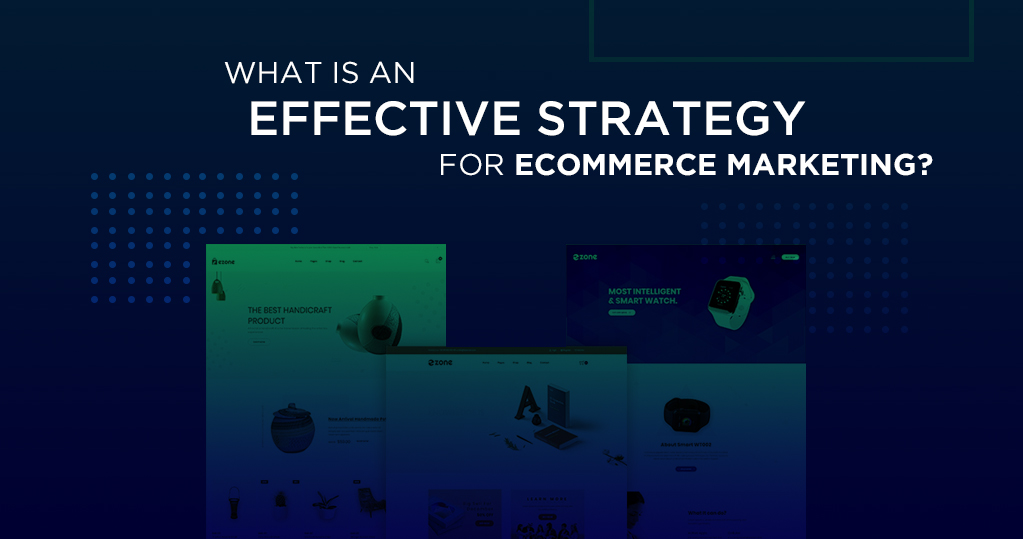If you are an ecommerce brand you want some effective ecommerce marketing strategies to attract new customers as well as inspire old customers to keep coming back to your store. With these proven ecommerce marketing strategies and tips, we are going to teach you how to bring in traffic to your site, build relationships and trust with customers, and get back those lost sales. Ready to grow your ecommerce business?
Ecommerce Marketing Strategies for Your Business
Define Your Sales Cycle
Every business is unique. How long does it take before a customer purchases on your site? Understanding how customers go through your sales procedure can be useful so that you can create the most ideal ecommerce marketing strategies possible.
If you don’t know how long it takes a customer to complete your sales cycle it will be difficult to pinpoint which platforms you should be advertising on, when you should be aggressively retargeting or sending emails. Does your customer convert in a week or a month or a year? Defining your sales cycle will require some research as well as testing.
Make your checkout process as easy as possible
Try to get everything on one page. If you have to have several pages, consider showing a progress bar at the bottom of each page so that your customers can visualize how much longer your checkout process will take. Make buttons easy to find – the more time a customer spends looking for the next button or the checkout button the quicker they can become frustrated with your site.
Francesca’s is a clothing store that has an easy checkout process. They have three sections all on one secure checkout page. The first section is for shipping information, the next for billing and finally, you can review your purchase. They include a photo of the product or products you are purchasing and break down your total amount so that you can see how much you are paying for shipping. You can also easily see all of the information you have entered and go back to make corrections without hitting the back button.
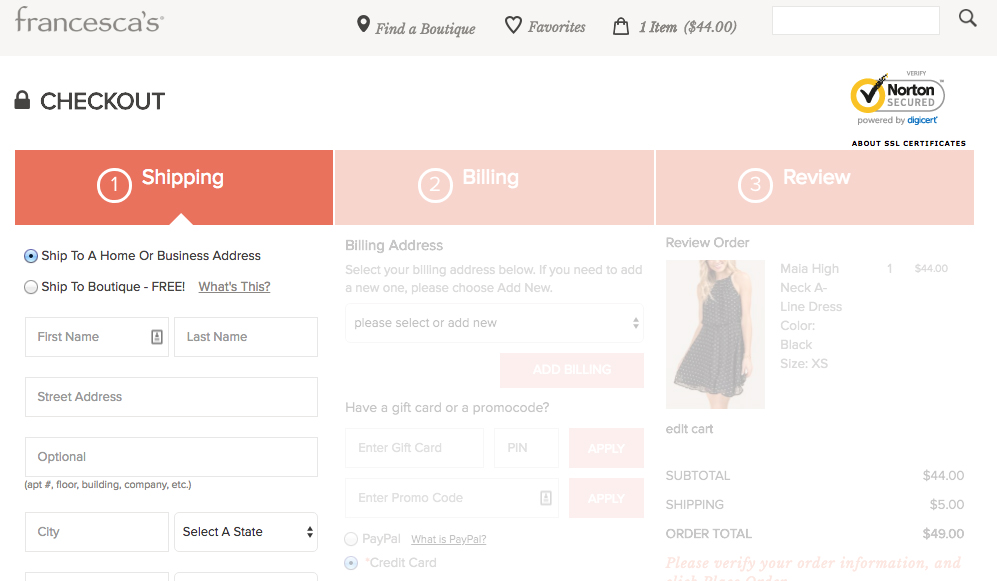
Show shipping costs
No one likes to go through the process of typing all of their information into your site and get all the way to the end only to find out that there is a huge shipping cost. Be upfront with customers. If you can, let them know how much they will be paying at the beginning of your check out process. Or charge a flat rate shipping if this is an option for your products.
In addition to being upfront about your shipping costs, give customers an idea of when their products will arrive or if there are any other shipping details they need to be aware of.
Francesca’s also shows shipping costs before you go to purchase your items and they offer the option to checkout with PayPal which is a trusted platform that many shoppers already use. If shoppers already have a PayPal account this expedites their checkout.
Another handy thing that PayPal and many other ecommerce brands are doing now is sending receipts through Facebook messenger. This makes it so easy for customers to keep track of their purchases. The easier you can make it for customers to purchase or return products, the more likely they are to return to your online store.
Optimize Your Checkout Process
Decrease cart abandonment by optimizing your checkout process. This is one of those ecommerce marketing strategies that is often neglected by businesses but it is possibly the most important one! You spend so much time building trust with potential customers to get them to purchase from you and you need to continue building that trust throughout your checkout process. If your checkout process is smooth and trustworthy from start to finish, you will increase conversion rates and decrease cart abandonment.
Give customers (and search engines) helpful product descriptions
Provide a size guide in case you’re selling any type of clothing or accessory. Not only will this help customers however it will reduce product returns for your business. You may want to include customer reviews or testimonials as well.
Make sure you have a page dedicated to frequently asked questions. This can also be beneficial to your SEO if you write quality descriptions that include keywords. Brush up on what SEO is and how it works before you dive in. Optimizing your descriptions will help you move up in search rankings which means more visibility for your business which can lead to more sales.
Let customers know what forms of payment you accept.
You can add the logos of what types of credit cards your store accepts. This helps build trust with shoppers and makes them feel safe when they are entering their credit card information. Add most preferable security seals to build trust, too. If customers recognize a security logo they will feel at ease knowing their credit card information is in good hands.
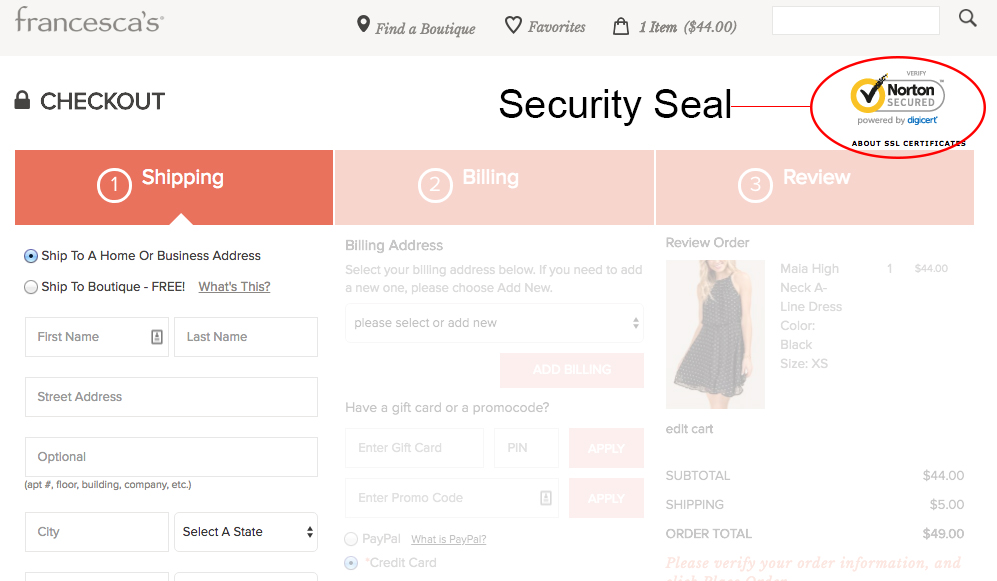
Francesca’s shows this popular security seal during their checkout process. It is easy to see and appears above the fold of the page. This can be a game-changer for your checkout process.
Retargeting
More than 98% of users don’t shop on their first visit to a website. If you need to capture those sales, then you will have to use retargeting ecommerce marketing strategies. There are many ways you can retarget shoppers so that they come back to your site to buy your product. One of the well-known ways is to run retargeting ads on other websites. When a customer returns to your site and leaves without purchasing anything, you can utilize other sites that they are visiting to showcase your products. Pretty cool right? You can also retarget customers with email campaigns. Have you ever added items to your cart in an online store without purchasing and then received an email a few days later that looked something like this?
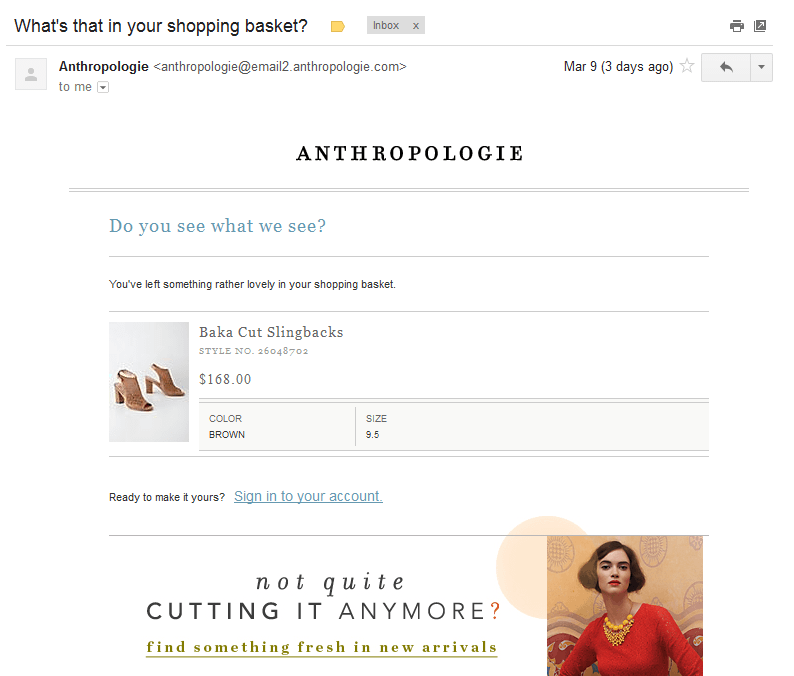
If so, you have just been retargeted. These emails may entice you to purchase items you have left behind or to shop for other similar/complementing items on the same site. This will increase traffic to your site which can get you more conversions aka more sales.
Email Marketing and Automation
Email marketing has a median return on investment of 122% which is 4 times higher than channels like social media, direct mail, and paid search. Building an email list is as easy as enticing users to give you their emails when they make a purchase. You can also collect emails through social media campaigns and on your website in exchange for coupons or discounts.
Creating an email marketing strategy can involve standing alone emails as well as automation. Read up on how to improve your B2C email marketing campaign. You can even set up email automation like cart abandonment, welcome automation, and order automation.
Cart abandonment emails retarget customers when they leave something in their carts. You have probably received one before reminding you to go back and purchase the items in your cart. It’s one of those “friendly reminder” ecommerce marketing strategies that will help your business regain those lost sales.
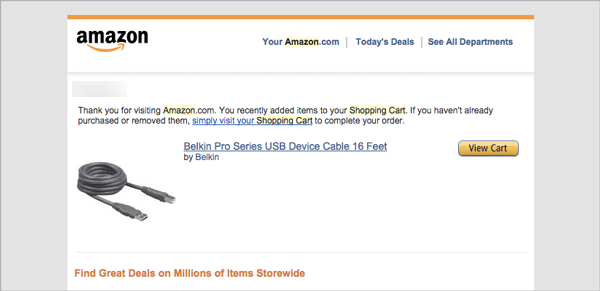
Welcome automation is ideal so that customers automatically get an email when the first sign up is done. You can include a short message about your brand and how you are happy to have them on board. If you want you can even include a coupon to entice them to purchase from your store.
Order automation is great for updating customers on their purchases. Several emails can be a part of this automation including a confirmation email letting the customers know you have received their orders, a shipping email confirming that the items have shipped and an email saying their products have been delivered. You can even send a fourth email asking how they like their products.
Asking for feedback or reviews is one of those ecommerce marketing strategies that are really easy to incorporate into any automation you may already have. After your customers receive your product ask for feedback! You can ask customers to simply rate your product or to leave a review. This is helpful for other customers when they are shopping for your products and it’s helpful for your business so that you can continue growing and improving.
Personalize the Buying Experience for Customers
If customers feel like your store is dedicated to helping them pick out the perfect product, then your store will rise above the rest. Utilize name personalization in your emails or on your website, suggest products depend on past purchases, or up your marketing game with a personalized quiz. This is a great way to connect with customers. Take them on a unique buying journey that is aligned with their tastes and styles.
Amazon does a great job of personalizing everything for customers. They show customers related products and recommendations of products they might like to purchase. Every customer dashboard looks different. It’s almost like every Amazon shopper has their own personalized Amazon store.
In Conclusion
Staying with the latest marketing techniques and trends is crucial for any successful ecommerce website. It’s significant to deliver interesting and valuable content and products that actually suite the requirement of your target market.
Reach out to your customers in a variety of ways and make sure you are working with a team of experts with varying skill sets. If you listen to everyone’s ideas, you may find new ways of improving your current campaigns and outreach methods.
Moreover, as always, ensure you are monitoring your website analytics to analyze trends, keep your website optimized, and track your outcomes!
With the right mix of marketing techniques, you can improve your conversion rate and attract sustainable businesses that will continue growing over time.


